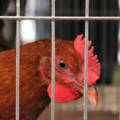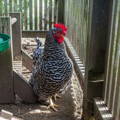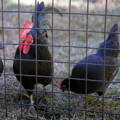
5 Steps For a Successful Integration of New Chickens to Your Flock
Discover how to seamlessly integrate new chickens into your existing flock with this comprehensive step-by-step guide. Learn the importance of quarantine, gradual introduction, supervised interaction, and effective integration techniques. Ensure a stress-free process by providing ample resources and monitoring flock dynamics.
FUN FACT: New chickens should not be integrated into the flock until they are comparable in size and able to defend themselves in pecking order challenges.
Subscribe
To join our mailing list and never miss an update!
Integrating new chickens into an existing flock can be a delicate process, but with proper planning and care, it can be successful. Here are some steps to consider when integrating chickens into your flock:
1. QUARANTINE
Before introducing new chickens, it's important to quarantine them for 10-14 days to ensure they are healthy and free from any diseases before introducing them to your established flock. This will greatly minimize the risk of transferring illness.
During the quarantine period, it's essential to provide the new chickens with a separate coop or enclosure away from your existing flock. The greater distance they are separated for this process the less risk of disease transmission.

2. SEPERATED INTRODUCTIONS
Once the quarantine period is over, you can start the introduction process. It's best to introduce new chickens to the existing flock gradually. You can do this by placing the new chickens in a separate but visible enclosure within the existing coop or run. A wire dog cage works well for this process.
This allows the chickens to see and get used to each other without direct contact. This step helps in reducing aggression and territorial behavior. Be sure to provide food and water for the new chickens while inside the cage. This process may take anywhere from just one day to a week, depending how they are received.
3. SUPERVISED INTERACTION
After a few days of visual introduction, you can start supervised interactions between the new and existing chickens. This can be done by allowing them to free-range together for short periods under your observation. Keep an eye on their behavior and intervene if any aggression occurs.
It's important to note that some pecking order disputes are normal during this stage as the chickens establish their hierarchy. Do not intervene while they are sorting out the new pecking order unless a bird is being injured or driven to the point of exhaustion.

4. INTEGRATION
Once the supervised interactions go well, you can proceed with integrating the new chickens into the existing flock. This can be done by allowing them to share the same coop and run. However, it's important to provide enough space, food, and water sources to avoid competition and aggression.
Ensure that there are multiple feeding and watering stations to prevent bullying and food/water blocking my dominant roosters or hens. Pay close attention over the next several days to make sure the new flock members have access to resources.
You may need to physically place the new chickens on the perch inside the chicken house for several evenings in a row until they understand this is their new sleeping quarters. As long as there is enough room in the chicken house, most chickens will begin automatically going into their new home at night after 3-10 nights of being placed on the roost manually.

5. MONITOR & ADJUST
Keep a close eye on the flock dynamics for a few weeks after integration. Some pecking order disputes are normal, but if any chicken is being excessively bullied or injured, you may need to separate them temporarily or provide additional hiding spots within the coop.
It's important to ensure that all chickens have enough space and resources to minimize stress and aggression. By eliminating the competition for resources, you will greatly increase your chances of a successful and stress-free flock integration.
Remember, each flock is unique, and the integration process may vary depending on factors such as the size of the flock, breed, and individual personalities of the chickens. Patience and careful observation are key to a successful integration.
In conclusion, integrating new chickens into an existing flock requires minimal but thoughtful planning and monitoring. By following the steps mentioned above, you can increase the chances of a successful integration. Remember to prioritize the health and well-being of your chickens throughout the process.
Trending Articles
Trending Products
Copyright©2023 All rights reserved. We love to have you share our article as long as you include a direct link to this page. Please contact us for permission and we’ll be happy to collaborate. This article or any portion thereof , including all images, may not be reproduced or used in any manner whatsoever without the express written permission of Gypsy Shoals Farm.



